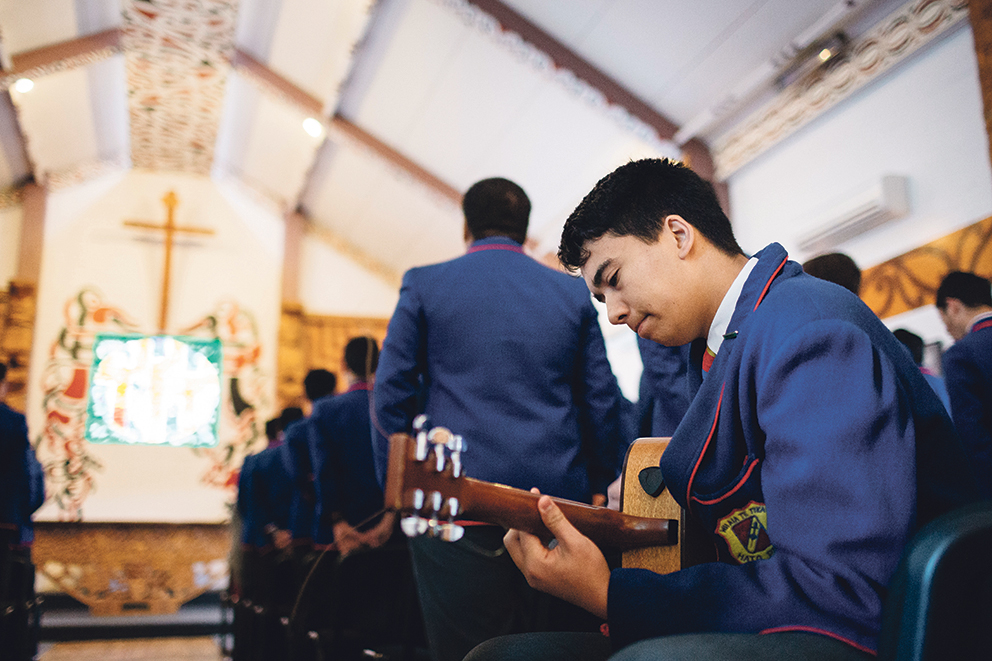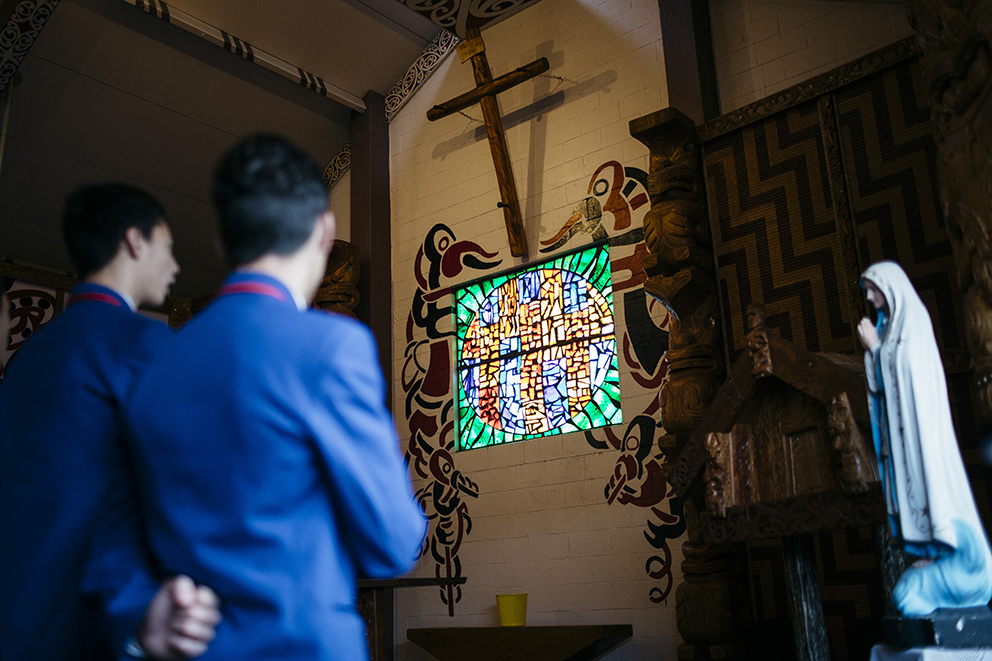WelCom December 2020

This month WelCom visits St Brigid’s parish community in Feilding (Aorangi) and its surrounding areas. The parish has a rich and diverse heritage since its beginnings in 1872, including the dedicated early parishioners with many descendants living in the area today; the work over several decades of The Society of Mary SM, The Sisters of St Joseph (rjs), The Sisters of St Dominic; the succession of Diocesan priests; the Marist Novitiate at Highden; numerous pastoral groups; and a growing multi-cultural community bringing a new dimension to this active and vibrant parish. St Brigid’s Feast Day is celebrated in the community in February every year.
Brief Parish History
1872: Fr Delphin Moreau sm, Māori missionary of Ōtaki, walked to Feilding to minister growing Catholic population. Bought land, built house, large room served as church for congregation until 1884. Feilding part of Ōtaki parish until 1875.
1875: St Patrick’s Palmerston North a parish; Feilding within boundary.
1883–84: Fr Denys Carew sm, PNth parish priest, proposed church in Feilding.
1884–86: Fr Matthais, first diocesan priest to PNth, oversaw Feilding church build.
1886: Archbishop Redwood opened St Brigid’s Church. Catholic population 70.
1889: Feilding separate parish. Fr J O’Meara, first resident priest.
1895: Ss Peter and Paul Church, Kauwhata Marae, opened by Archbishop Redwood.
1906: Sisters of St Joseph’s of Nazareth of Whanganui set up convent. Taught seven pupils in front room.
1908: Parishioner Mrs Walter Woods-Johnston of Highden funded school in memory of late husband. St Joseph’s Convent School of four classrooms opened 1909, for up to 200 pupils.
1911: Church of Immaculate Conception, Apiti, opened by Archbishop Redwood. Deconsecrated in 1970s.
1912: St Patrick’s Church, Kimbolton, opened.
1923: Highden Manor Estate purchased for Novitiate for Marist Religious formation.
1925: Archbishop Redwood celebrated Consecration Mass for new gothic St Brigid Church.
1928: Fr Brougton parish priest to Feilding.
1942: Highden permanent base for Manawatu Māori Mission.
1947–48: Archbishop of Wellington bought homestead near Cheltenham for Hato Pāora boarding school for Catholic Māori Boys. Fr Issac Gupwell first rector.
1952: Sisters of St Dominic arrived, relocating school for Deaf from Wellington.
1955: Fr Hanratty replaced Fr Broughton. New classroom for St Joseph’s. Fire at Highden.
1957: Catholic Women’s League group started.
1959: St Vincent de Paul Feilding Conference established; 50th Jubilee 2009.
1967: Presbytery opened by Bishop Sneddon.
1967: SVdP Fielding Conference involved with buying and renovating Ozanam House.
1968: Two new classrooms built at St Joseph’s.
1970: New St Patrick’s Church built at Kimbolton. Blessed and opened by Cardinal McKeefry. Mass now monthly.
1980: St Joseph’s School condemned. New four-room classroom opened 1984.
1986: Tree planted at St Joseph’s for Sisters’ departure.
1989: St Dominic’s School closed. Classroom block relocated to St Joseph’s as new Deaf wing.
1990: Highden Novitiate closed, later sold.
1993–2001: Society of Mary responsible for parish of St Brigid’s Feilding, continued pastoral care to Hato Pāora College and Catholic Māori Mission of Manawatu.
1996: St Marlen Dunn rsj, last resident Sister of St Joseph to depart Fielding.
1997: Parish Pastoral Council formed.
2001: Society of Mary relinquished responsibility for parish and vacated presbytery.
2002: Diocese responsible for parish; first Lay Pastoral Co-ordinator appointed.
2008: St Brigid’s Church, presbytery demolished, land sold.
2008–09: New St Brigid’s Church constructed, blessed by Bishop Peter Cullinane.
2009–10: Fr Brian Walsh parish priest.
2014: St Brigid’s parish, 125th Jubilee.
St Brigid’s Parish
Vicki Messenger
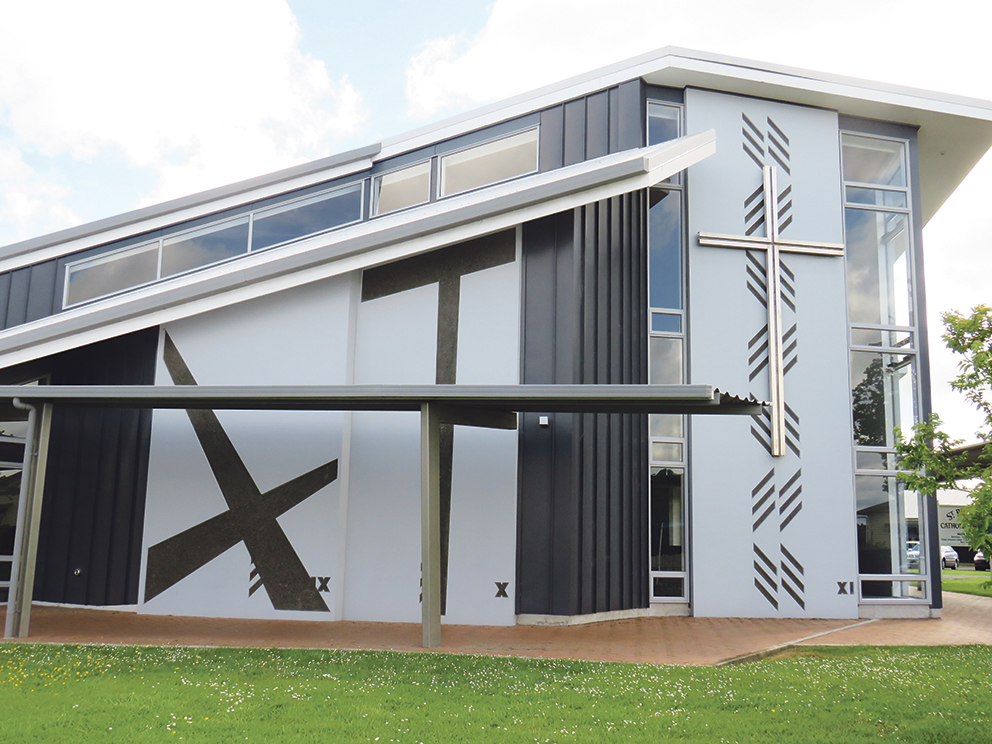
St Brigid’s Parish is situated in the town of Feilding, Manawatu District, North Island. Widely known as Friendly Feilding, it has won the annual New Zealand’s most beautiful town award 16 times. Feilding is a service town for the surrounding farming district. The town has seen strong growth in the last 10 years to a population of 17,300.
St Brigid’s present-day church is the third built on the site to house the Catholic faith community of Feilding since it first came to the area in 1872.
The present church, opened in 2009, has won architectural awards for its structure. The exterior wall panels include the unique feature of the engraved 15 stations of the cross. They were designed by Professor Robert Jahnke (Ngāti Porou) as Head of the Māori Visual Arts programme at Massey University. The recurring pattern of three small parallel lines is taken from traditional Māori art and culture. The primary focus of his work is the mutual cultural appropriation between Māori and Pakeha.
Our priests are Fr Manoj Matthew IC and Fr Robin Kurian IC of the Rosminian Order and have been in Feilding with us since 2016. Their attitude and gentle personalities have proved a plus in bringing together the multi-cultural aspect of our parish.
The parish roll today is approximately 400. We enjoy Masses run by the different cultures in our parish. The congregation consists of many generations of families who have lived their whole lives in the district to those who have arrived more recently. Everyone is warmly absorbed into the community.

A golf tournament has become a major parish event in the last two years and is run as a Social Justice initiative. All profits have gone to Manchester House – a social services society – to support the important and life-changing work they perform over the entire community. Our St Vincent de Paul conference volunteers do a tremendous amount of work fulfilling Catholic Social Justice Principles but depend on Manchester House to provide the services they are unable to. Over the past year SVdP volunteers have worked closely with Manchester House to support several families and they have seen the extensive services provided those in need. During Covid lockdown, the volunteers delivered 200 food parcels to pensioners. Parishioners are generous with their donations – one even donated a brand-new freezer that allows meat and other food items to be stored and handed out when needed.
We have a variety of groups within the parish. The main purpose of some of the groups is the inter-faith community within Feilding, which comes together in prayer at Easter and Advent. We hold garage sales, raffles, potato-growing competitions, quiz evenings and a variety of concerts all of which the parishioners support and run.
We have strong links with St Joseph’s Primary School with weekly Masses attended by classes at the school. All students attend the end-of-term and end-of-year Masses. Several students are members of our Young Vinnies group and are supervised and mentored by St Vincent de Paul adults.
We have weekday Masses on Wednesday, Thursday and Friday with one Sunday Mass at 9am. Every Sunday Mass is followed by a morning tea where parishioners gather to socialise. The weekday Mass is well attended and has become a close-knit group of people.
If you ever find yourself in our area and want to join us you will find a warm welcome.
St Vincent de Paul Conference 2020
St Brigid’s Parish has a St Vincent de Paul Conference with 14 active and four associate members. They make regular visits to people in their homes and in rest homes and hospitals.
An enthusiastic group of Young Vinnies from St Joseph’s School are an integral part of the conference and their initiatives are supported and encouraged by the adult conference members. Together, they have actively participated in food-parcel preparation and delivery to elderly residents in local social housing, visits to local Rest Homes, assisting with Parish Anointing Masses and fundraising to support those in need. The Young Vinnies are also active in raising awareness of needs within our community.
The St Brigid’s Conference has strong links with other local social service groups including The Salvation Army and Manchester House who all co-operate to provide a variety of help to meet the needs of people in our community. Local service groups and some businesses also give generous donations of funds and goods to help Vinnies meet ongoing requests for help.
Parishioners strongly support the Conference and always make generous and regular responses to requests for assistance with food, clothing, furniture and donations for national and local appeals.
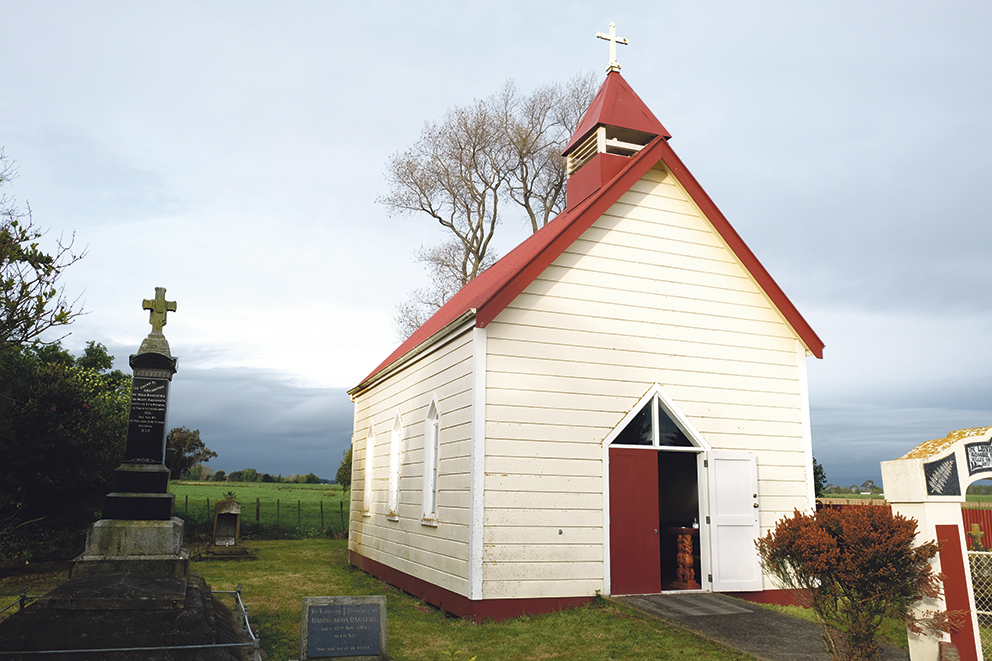
St Peter and Paul Catholic Church at Kai Iwi Marae (Kauwhata), Feilding. The building of this church was led by Te Raika Kereama, and it was officially opened on 20 October 1895 by Archbishop Redwood. Its 125th anniversary was celebrated on 20 October 2020.
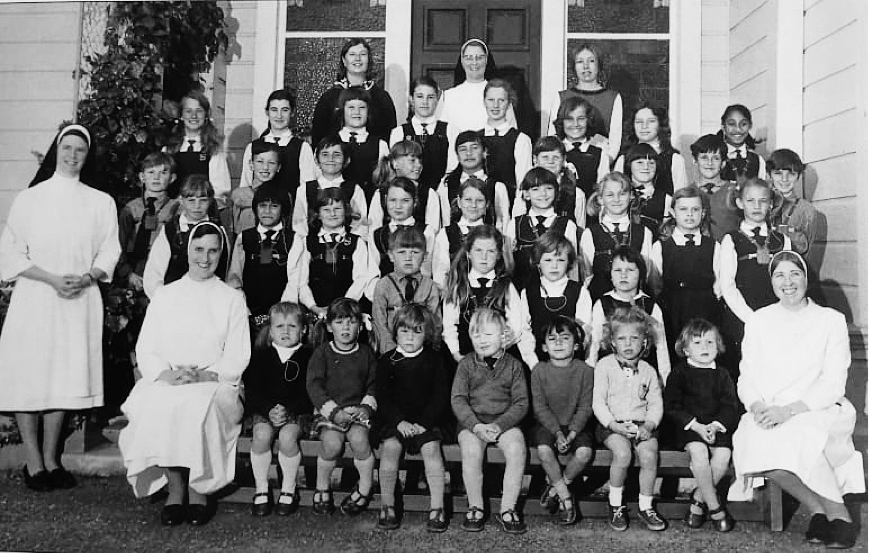
The Sisters of St Dominic arrived in Feilding in 1952 when St Dominic’s Catholic School for the Deaf was relocated from Wellington. Over the next 40 years the Sisters provided education for Deaf students at a boarding school homestead. Students and staff enjoyed a close and supportive relationship with the Feilding community.
Hato Pāora College
Dr Nathan Matthews, Tumuaki – Principal, Ngā Puhi
Hato Pāora College is located 10 kilometres outside of Feilding in Cheltenham. It is the only remaining Māori Catholic boarding school for boys since the closure of Hato Petera College in 2018. Hato Pāora College was opened in 1947 by the Society of Mary as an extension of their Māori Mission within the then Archdiocese of Wellington. It was focused on providing a Catholic education to Māori boys and as such continues to promote a Māori Catholic dual special character. This is seen in the practice of the Catholic faith informed and supported by tikanga Māori throughout all aspects of College life.
The school is situated on a large rural site that incorporates the school facilities and the hostel. There are 120 students from all over the country all of whom board full time. The college offers a curriculum based on
its special character where Te Reo Māori and Religious Education are the priority learning areas. Kapa haka is also a priority and it is something the College has been well known for, particularly way in which the students sing.
There have been a number of notable old boys over the years who have had success across a range of professional, cultural, sporting and religious endeavours. Hato Pāora College has provided four out of five Māori priests, and Bishop Max Takuira Mariu, the only Māori Catholic Bishop. Sir Te Atawhai Taiaroa and Morvin Anatipa Simon are two old boys who contributed strongly to Māori society and Māori development. More recently Damian Stone has been elevated to the position of Judge within the Māori Land Court after an extremely successful career as a lawyer. Former student Otere Black also plays rugby for the Auckland Blues and New Zealand Māori All Blacks. Dr Areti Metuamate, chief executive of Te Kupenga, New Zealand’s Catholic tertiary institute, is a Hato Pāora old boy. His wife Dr Jessa Rogers is on the Hato Pāora Trust Board.
The grand Highden manor
Michael Fitzsimons

Deep in the heart of the Manawatu, encircled with native bush and well concealed from the road, is a remarkably grand manor house and farm that served as a novitiate for the Society of Mary for 67 years from 1923 to 1990. The novitiate year usually came in the second year of formation. Students for the Marist brotherhood and priesthood spent exactly 365 days at the Awahuri property, receiving intense religious training in the Marist way of life, culminating in the taking of first vows of poverty, chastity and obedience.
Highden Manor House was originally built by Walter Woods-Johnston, a member of Parliament for Manawatu for 13 years and was named after the Sussex Estate of his wife’s father, Sir Charles Forster Goring, 7th Baronet of Highden. Walter Johnson bought the land in 1888 and built the house 10 years later. Under the supervision of Mrs Johnson, the grounds were beautified with two acres of rose gardens. The estate was subsequently broken up into two lots – a large block of around 1,000 acres and the homestead block of around 220 acres with the house, farm buildings and stand of native bush. This part retained the name of Highden and was purchased by the Marists in 1923 for 17,000 pounds.
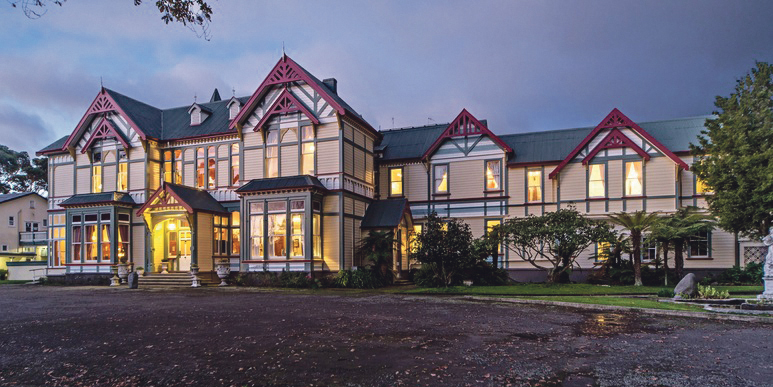
Photos: Marist Archives; Highden Manor House website
Over the years the property had multiple uses, becoming a house of philosophy for Marist seminarians following the Napier earthquake in 1931, and in 1942 it was also used as a base for the Manawatu Māori Mission. Occasionally it was used as a second novitiate (period of renewal) by professed Marists. In 1955 a fire in an ancillary building led to a rebuild of the chapel and accommodation block. Farming land on the estate was extended and improved by the brothers, with Brother Joachim an innovative and colourful character in its development. A splendid rose garden, sizeable but smaller than the original, was retained at the front of the manor house.
Fr Con O’Connor was the novitiate’s longest serving novice master (23 years) and he served a further 11 years as socius on the staff at Highden.
At various stages in its history, financial challenges associated with the property and questions about its suitability led to the property being put on the market. But in the end the Society of Mary held onto Highden until May 1990, when declining student numbers led to its sale. These days the property has been developed into a high-end boutique hotel.
Michael Fitzsimons is a Highden old boy.
St Joseph’s School
Claire Warren
St Joseph’s is a small Catholic school nestled in friendly Feilding. We are an inclusive and nurturing school that supports our children to grow in their faith and in their relationship with Christ. Our school was established in 1906 by the Sisters of Saint Joseph of the Sacred Heart (Josephites; Brown Joeys) to serve the Parish of Saint Brigid’s.
We currently have a role of 130 akonga – students, with six classrooms from New Entrants to Year 8. An experienced and faith-filled staff support our children in their learning and individual faith journeys. Staff are nurtured and grown through regular prayer opportunities, study through Te Kupenga – Catholic Leadership Institute, and other professional development and formation opportunities.
We have strong connections with our parish and strengthened through our Young Vinnies programme. Mary MacKillop’s guiding phrase ‘never see a need without doing something about it’ can be seen in the service and outreach our students provide to our community. We enjoy sharing celebrations and important events as a school and parish community.
At St Joseph’s we have well established CARE values – community, acceptance, respect and excellence. As a whole school community, our staff and students live out these values through their lives and interactions with others. The values are the pillars of our behaviours in the school.
Through a vibrant prayer life, uplifting liturgies, regular weekday Masses and a robust religious education curriculum we try to facilitate a meaningful encounter with Christ. Catholic Social Teachings are instilled into all we do and are an integral part of who we are as a community. Liturgical celebrations and feast days are often shared with the parish, which nurtures and develops our faith and knowledge of the Catholic tradition.
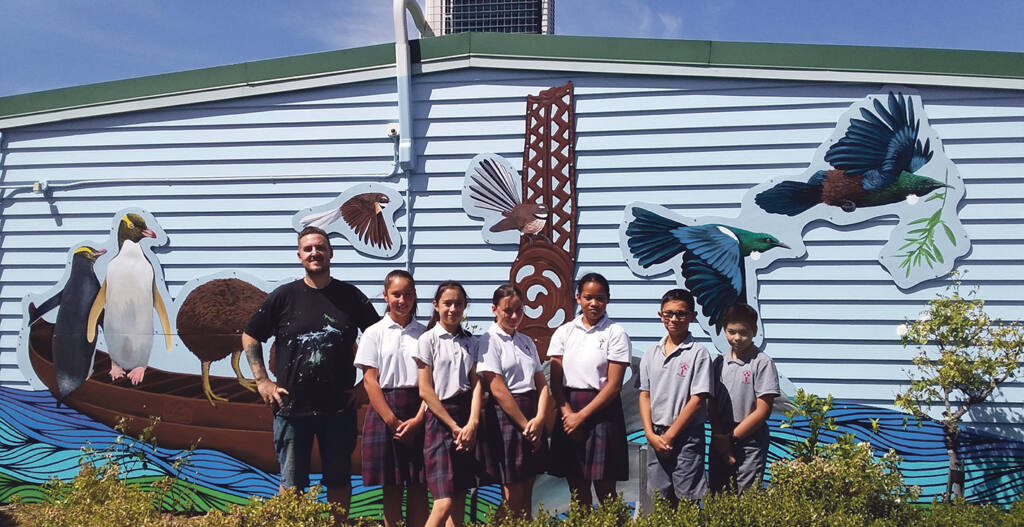
Year 8 students in front of Aotearoa Noah’s Ark with local artist Joe McMenamin. 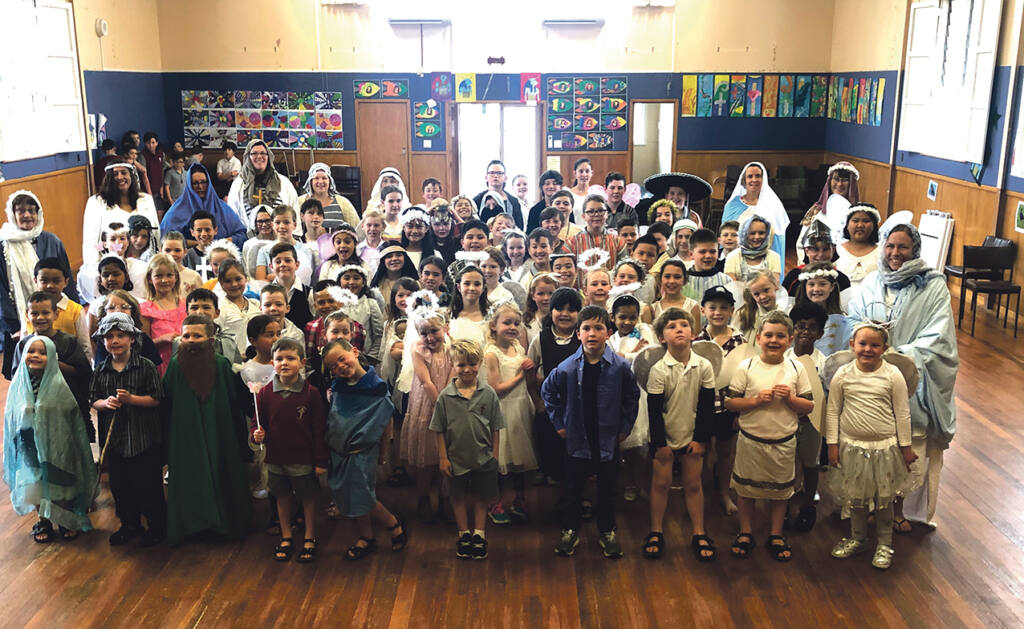
St Joseph’s School nativity play production. Photos: Supplied
Young Vinnies
St Joseph’s school has a very enthusiastic group of nine Young Vinnies. While any child from the senior school is welcome to join, this year’s group has consisted of nine kind, girls. It is heartening to see such a caring group of young people. They started the year making bead bracelets to sell at the parish garage sale. However, with the changes brought on by Covid-19 their thoughts turned to the elderly people in our local rest homes.
The girls spent their lunchtimes writing little notes to send to the residents so they would feel remembered. They also found at their homes, good quality toys they had grown out of and so donated to them to children in local safe houses. The group has also helped with assembling food parcels given out through the school. And they assembled food parcels taken to elderly residents in local council flats and to elderly neighbours next to the school. The gifts were well received and the girls were greatly uplifted by the experience. Currently, they are tending the school vegetable garden so this produce can be added to the school’s donated food parcels.
The girls willingly pursue opportunities to serve in our parish and local community, truly demonstrating the St Vincent de Paul spirit.

